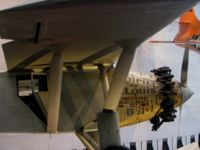Spirit of St. Louis

The Spirit of St. Louis is a plane that Charles Lindbergh used to be the first person to fly solo nonstop across the Atlantic Ocean. On May 21, 1927, Lindbergh completed the 33 hour flight from Long Island, New York to Paris, France, in the custom made plane. The $15,000 plane's construction was completed on April 1927. Aircraft designer Donald Hall, under the supervision of Lindbergh, originally tried to create the plane by modifying the Ryan M-2, however this attempt failed; and they started on a custom made design.[1]
Using his personal savings and donations from wealthy businessmen, Lindbergh completed the plane in April 1927. Herold Bixy, a St. Louis banker and one of the founders of the plane construction named the plane in honor of the support that Lindbergh received from the city. Although Raymond Orteig, a wealthy New York businessman, was offering $25,000 to the first person to fly non-stop across the Atlantic, Limdbergh, was motivated by the desire to demonstrate aviation's potential.[2] On April 30, 1928 the Spirit of St. Louis was placed on display at the Smithsonian in Washington, D.C., where it remains as one of the most visited exhibits.
Design
| Wingspan | 14 m (46 ft) |
| Length | 8 m (27 ft 8 in) |
| Height | 9 ft, 10 in |
| Weight, gross | 5,135 lb |
| Weight, empty | 975 kg (2,150 lb) |
| Engine | Wright Whirlwind J-5C, 223 hp |
| Manufacturer | Ryan Airlines Co., San Diego, Calif., 1927 |
Facts
- Weeks before the Spirit of St. Louis' flight, French pilots Charles Nungesser and navigator Francois Coli left Paris for New York in a single-engine biplane. Both of the pilots went missing after takeoff.[3]
- The crowd that met Lindbergh in Paris consisted of 150,000 people.
- Before Lindbergh's flight, four pilots had tried to cross the Atlantic non-stop.[4]
